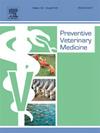利用蜱虫分布和气候模型预测中国未来热带蜱虫病风险
IF 2.4
2区 农林科学
Q1 VETERINARY SCIENCES
引用次数: 0
摘要
热带线虫病是由环纹线虫引起的蜱传原虫病,发病率和死亡率高。虽然气候变化和牲畜贸易的扩大可能会增加传播风险,但在未来气候情景下,中国热带线虫病的空间分布动态仍不清楚。本研究旨在综合气候变量和蜱虫媒介分布资料,预测中国热带蜱虫病未来的分布动态。我们开发了两个基于maxent的预测框架:一个框架仅包含19个气候变量,另一个框架将这些变量与四种主要蜱虫媒介(scupense蜱虫、anatolicum蜱虫、detritum蜱虫和asiaticum蜱虫)的分布数据相结合。在3种气候情景(SSP126、SSP245和SSP585)下,预测了3个时期(2021-2041、2041-2060和2061-2080)的风险区。使用曲线下面积(AUC)度量来评估模型性能。结果表明,蜱虫分布数据的整合提高了模型的预测精度(AUC: 0.874 ~ 0.882)。目前主要分布在中国中部和西北部的高风险区与碎尸门菌的分布有很强的相关性。在未来的气候情景下,该模型预测蜱虫媒介可居住区域和疾病风险区域的收缩。在SSP126情景下,预计2061-2080年降幅最大(14.39 %)。本研究对气候变化情景下中国热带血吸虫病风险动态进行了系统评估。媒介分布整合提高了预测精度,强调了媒介生态学与气候数据相结合在疾病风险建模中的重要性。这些发现支持制定考虑到病媒分布模式和区域气候特征的有针对性的预防战略。未来的疾病管理规划应优先考虑病媒监测,制定相关政策,有效降低疾病传播风险。本文章由计算机程序翻译,如有差异,请以英文原文为准。
Predicting future tropical theileriosis risk in China using tick distribution and climate models
Tropical theileriosis, caused by Theileria annulata, is a tick-borne protozoan disease with high morbidity and mortality rates. While climate change and expanding livestock trade may increase transmission risks, the spatial distribution dynamics of tropical theileriosis in China under future climate scenarios remain poorly understood. This study aimed to predict the future distribution dynamics of tropical theileriosis in China by integrating climate variables and tick vector distribution data. We developed two MaxEnt-based prediction frameworks: one incorporating 19 climatic variables alone, and another combining these with distribution data of four major tick vectors (H. scupense, H. anatolicum, H. detritum, and H. asiaticum). Risk zones were projected across three periods (2021–2041, 2041–2060, and 2061–2080) under three climate scenarios (SSP126, SSP245, and SSP585). Model performance was evaluated using the Area Under Curve (AUC) metric. The results showed that integration of tick vector distribution data improved model prediction accuracy (AUC: 0.874–0.882). Current high-risk zones, predominantly in central and northwestern China, showed strong correlation with H. detritum distribution. Under future climate scenarios, the model projected a contraction of tick vector habitable areas and disease risk zones. The most substantial reduction (14.39 %) was predicted for 2061–2080 under the SSP126 scenario. This study provides a systematic assessment of tropical theileriosis risk dynamics in China under climate change scenarios. The improved prediction accuracy achieved through vector distribution integration emphasizes the importance of combining vector ecology with climate data in disease risk modeling. These findings support the development of targeted prevention strategies that account for both vector distribution patterns and regional climate characteristics. Future disease management planning should prioritize vector surveillance and formulate relevant policies to effectively reduce the risk of disease transmission.
求助全文
通过发布文献求助,成功后即可免费获取论文全文。
去求助
来源期刊

Preventive veterinary medicine
农林科学-兽医学
CiteScore
5.60
自引率
7.70%
发文量
184
审稿时长
3 months
期刊介绍:
Preventive Veterinary Medicine is one of the leading international resources for scientific reports on animal health programs and preventive veterinary medicine. The journal follows the guidelines for standardizing and strengthening the reporting of biomedical research which are available from the CONSORT, MOOSE, PRISMA, REFLECT, STARD, and STROBE statements. The journal focuses on:
Epidemiology of health events relevant to domestic and wild animals;
Economic impacts of epidemic and endemic animal and zoonotic diseases;
Latest methods and approaches in veterinary epidemiology;
Disease and infection control or eradication measures;
The "One Health" concept and the relationships between veterinary medicine, human health, animal-production systems, and the environment;
Development of new techniques in surveillance systems and diagnosis;
Evaluation and control of diseases in animal populations.
 求助内容:
求助内容: 应助结果提醒方式:
应助结果提醒方式:


